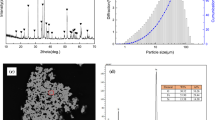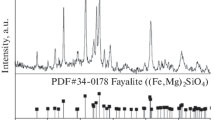Abstract
The direct production of copper sulphate from copper ore is an important route to recover copper. The condition, however, is dependant on temperature and sulphatising environment. The oxidation of chalcopyrite in static air bed condition has been studied by TG/DTA and DSC techniques. The addition of catalysts, improved the sulphation by in-situ producing better condítions. The mutual effects of sulphides were further confirmed by studying the oxidation reaction on pure copper-iron sulphides and results so obtained were corroborated with X-ray diffractrograms. With only chalcopyrite a mass gain of 8% (TG) corresponding to copper sulphate formation was observed, in the temperature range 628–738 K. The TG plots showed respective mass gain of 14, 17 and 12% in presence of Fe2O3, Na2SO4 and FeSO4 with chalcopyrite in the wider temperature range 628–923 K. As such the cupric sulphide had a negligible tendency of sulphation, which increased with the addition of ferrous sulphide mixture under the temperature range studied. At higher temperature copper ferrite formation was found.
Similar content being viewed by others
References
M. Aneesuddin, P. N. Char, M. Raza Hussain and E. R. Sexena, J. Thermal Anal., 26 (1983) 205.
E. M. Kurian and R. V. Tamhankar, Trans. Indian Institute Metals, 24 (1971) 17.
K. S. Rao, R. P. Das and H. S. Ray, In Proc. of International Conference on Base Metals Technology, Jamshedpur, India 1989, p. 131.
D. J. Vaughan and J. R. Craig, Minerals chemistry of metal sulphides, Cambridge University Press, London 1978, p. 299.
P. C. da A. Naves and A. J. Lakschevitz, Metal ABM, 31 (1975) 367.
G. Bayer and H. G. Wiedeman, Thermochim. Acta, 64 (1983) 27.
T. R. Ingraham, In: Applications of Fundamental Thermodynamics to Metallurgical Process, G. Fetterer ed., 1967, p. 179.
I. D. Shah and S. E. Khalafalla, U. S. Govt. Re. Develop. Rep., RI 7459 (1970) 1.
M. E. Wadsworth, K. L. Leiter, W. H. Porter and J. R. Lewis, Trans. AIME, 218 (1960) 519.
E. A. Peretti, Disc. Faraday Soc., 4 (1948) 174.
G. R. Jr. Smithon and J. E. Jr. Hanway, Trans. AIME, 224 (1962) 827.
M. G. Hocking and C. B. Alcock, Trans. AIME, 236 (1966) 635.
M. Shamsuddin, N. V. Nogc and P. M. Prasad, Met. Mater. Processes, 1 (1990) 275.
N. R. Mandre and T. Sharma, In: Proc. National Seminar on Research and Process Development in Mineral Preparation, Jamshedpur, India 1992, p. 128.
S. C. Panda, L. B. Sukla and P. K. Jena, Can. Metall. Quart., 29 (1990) l41.
S. Prasad, B. D. Pandey and S. K. Palit, Mat. Trans. JIM, 37 (1996) 1304.
F. Opera, Min. Metall. Quart., 3 (1963) 193.
R. I. Razouk, M. Y. Farah, R. S. Mikhail and G. A. Kolta, J. Appl. Chem., 12 (1962) 190.
S. E. Khalafalla and I. D. Shah, Metall. Trans., 1 (1970) 2151.
H. H. Kellogg, Trans. AIME, 230 (1964) 1622.
P. G. Coombs and Z. A. Munir, Metall. Trans., 20B (1989) 661.
S. Prasad and B. D. Pandey, NML Technical Journal, 39 (1997) 229.
Author information
Authors and Affiliations
Rights and permissions
About this article
Cite this article
Prasad, S., Pandey, B.D. Thermoanalytical Studies on Copper—Iron Sulphides. Journal of Thermal Analysis and Calorimetry 58, 625–637 (1999). https://doi.org/10.1023/A:1010108729034
Issue Date:
DOI: https://doi.org/10.1023/A:1010108729034




